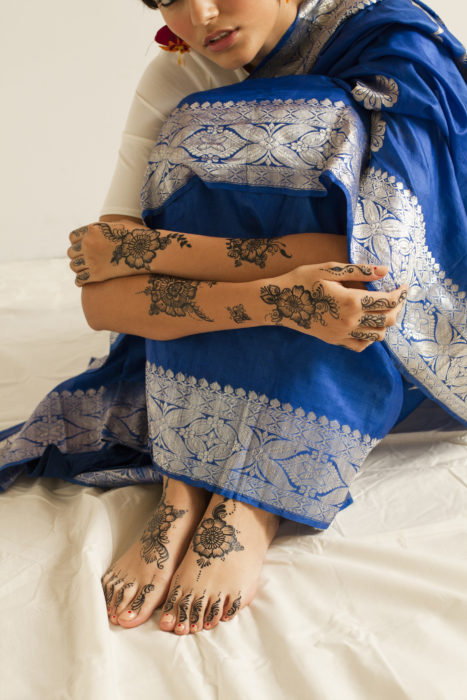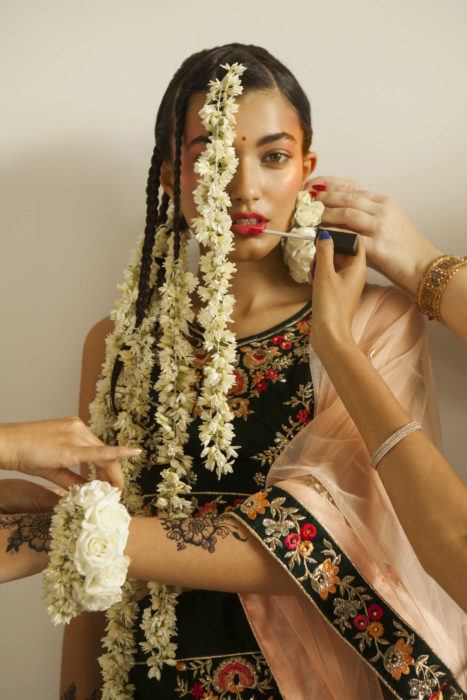Beauty Rituals Of A Hindu Wedding

No matter where in the world any of my family weddings have taken place, there seems to be a universal truth: the bride will always have the most glowing skin on her big day. As she walks down the aisle her skin glows radiantly and her hair glistens.
Indian weddings take place across three to five days with many early mornings and late nights. So this means that we all endure our fair share of puffy eyes, frizzy hair and dull skin. But the real secret is that these events are actually peppered with ceremonies solely dedicated to beautifying the bride. So it is no wonder that she always looks absolutely flawless.
The significance of the bride being this embodiment of a supreme beauty dates back to childhood. Growing up in a Hindu household, we were always taught that daughters bring in the blessings to their families. We are treated as goddesses – specifically Lakshimi (the goddess of wealth and purity) – and this role carries on throughout our lives even when we are walking down the aisle.

It all begins two days before the wedding at a daytime event known as the Mehndi. All of the ladies from both sides of the family get together and dance, while a professional artist paints henna on the bride’s hands and feet. A bride’s henna will typically appear in a floral or paisley pattern up to her elbows and calves. The intricately decorated patterns are left on overnight to dry and it turns into an aesthetically pleasing deep red colour. Henna is not only used for its visual charm, but its scent also helps to relieve any tension.
During a Mendhi ceremony wedding, guests can also have henna painted onto their hands for good luck. It is believed that when women apply henna it symbolises beauty and joy. But instead of having henna painted up to their elbows, guests typically opt for dots, loops and small geometric patterns on their palms. These timeless styles can be modernised with cutouts, where the artist draws out the borders of leaves and flowers instead of shading in each pattern.

After a heavy night of dancing and partying, the next day can be particularly gruelling for the bride, as she has to carry out a morning prayer to bless her future household. Then close family and friends take her to be formally introduced to the groom’s side. This is a slightly different pre-wedding ritual to other communities, but I have participated in this ceremony several times because my family is from a place formerly known as Sindh. This additional step is called the Saagri, which is essentially a makeover for the bride.
The groom’s female relatives take turns applying cosmetics onto the bride, such as perfume, blush and lipstick. She is welcomed by each member of her spouses’ family with a floral token, such as a garland, bracelet or headdress. The significance of this ceremony is to show that they are taking in a new goddess into their home, who will bless them with abundance.
Other communities might perform purifying customs the day before the wedding to ensure their brides have the most glowing skin with the help of turmeric but for us this takes place on the day of the wedding.

It is no surprise that turmeric is now seen as a buzzy ingredient of the moment, this wonder herb has been used for generations to brighten the skin and calm the mind. Close friends and family apply a blend of turmeric, chickpea powder and rosewater (also known as Pitthi) onto the bride’s face and neck.
But there is a deeper meaning to this ritual aside from promoting perfect skin. Indian astrologers believe turmeric is linked to Jupiter, which is the planet of marriage, this ceremony is also conducted to attract Jupiter’s energies to the couple and further bless the marriage.
During the turmeric ceremony, coconut oil is also massaged onto the bride’s scalp. This is to encourage hair growth and it is also a deep conditioning treatment, so she has glossy locks on her special day. This is especially important for South Indian brides, who weave flowers and lavish silver and gold accessories into a plait or bun. When braiding the hair, coconut oil also helps to keep any flyaways at bay.

A final touch before the blushing bride walks down the aisle is the placement of a bindi (a small red dot) on her forehead between the eyebrows. This area on the face is said to hold the sixth chakra, which is a concentrated area of wisdom. It is believed that energy rises from the base of the spine towards the head and this creates an outlet for increased levels of awareness. This heightened level of power also helps to supply blood to the facial muscles, which makes the bride look awake and fresh.
We all aspire to look like we had the best sleep of our lives, while feeling super calm and composed on our wedding day. And these traditional Indian customs may have the answers we are all searching for.
See our latest editorial inspired by these Hindu wedding beauty rituals here.
Words: Disha Daswaney, Photography: Michele Cote, Art Director: Nila Mistry, Beauty Direction & Styling: Abisoye Odugbesan, Hair Stylist: Terri Capon, Make -Up Artist: Simmone Aziz, Nail Artist: Kione Grandison, Henna Artist: Asma Ali, Model: Sasha Pereira @premier, Floral Designer: Bijou & Bloom by Raj.
We've got great things to share!
Sign up for our weekly newsletter
and we'll keep you updated.
You can unsubscribe at any time
Terms & Privacy